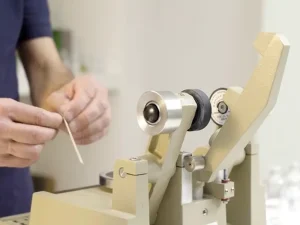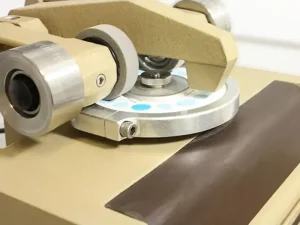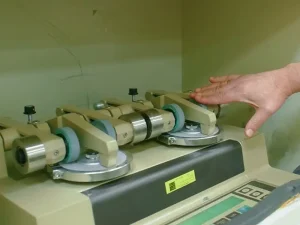The Taber abrasion test method is integral to the quality control system. Many manufacturers use this test to make their products trustworthy. It checks how good a material or product is against abrasion and friction. Remember, this test is only used by the manufacturers.
So, the layman customers don’t understand its importance. Moreover, those new to manufacturing industries want to enhance their product quality. There is no other way to use this test to identify weaknesses and improve. If this method excites you, stay tuned till the end. We will explore all things related to this testing method.
Overview of Taber Abrasion Test

This testing machine uses wheels and applies abrasion and friction to the sample. This abrasion is similar to what a product faces in the real world. The wheels move and cause friction in the sample. This abrasion due to wheel movement can wear the sample and check its wear resistance and quality.
Edward Taber invented these testing machines in the 1930s. So, it is not new and has been serving for many decades. This testing machine has many components that make the testing possible. Here is the list of their names:
- Sample holder
- Load Weights
- Rotating Platform
- Two abrasive wheels
- Counter or screen for tracking
The sample holder keeps the sample secure. The sample is placed on the rotating platform, which rotates. The abrasion wheels of this machine cause an abrasion on the sample. One complete rotation of the rotatory platform is equivalent to one cycle. The machine’s counter shows the many cycles a material undergoes.
In this test, abrasive wheels are of the utmost importance. They are responsible for scratches, abrasion, and surface scuffing. These abrasions play a critical role. A strong and durable sample will remain in good shape even after face abrasion and vice versa.
But the question arises: How do the operators know the test result? The operator puts a set number of cycles on the screen, e.g., 1000. He will take the sample out after 1000 cycles and check its weight. Suppose the weight is reduced significantly compared to its weight before the test. So, the quality of the material is not good, and vice versa.
Quick Tip: Some operators also use cycle counts to evaluate the test result. If a material is of good quality, it will withstand more cycles, and vice versa. Generally, 1000 cycles are set as a standard for testing material under the Taber abrasion method.
Step-by-Step Method of Taber Abrasion Test

Conducting the Taber aberration test is a bit complex. However, the process will be much easier if you know and understand the components. I’ve mentioned critical elements in the section above. Let’s dive deep and discuss the steps involved in the Taber abrasion test.
1- Choose Material (Sample)
Some people believe that the whole product undergoes this testing. This is wrong; only a tiny part of the main product is good enough for testing. Generally, operators use small pieces of 100 mm (4 inches) in this testing process. The piece is cut from the primary material to contain all the properties of the primary part.
Suppose you are testing a fabric. For this, you’ll have to cut a piece of cloth with all the properties of the primary fabric parts. If the primary material has different designs or patterns, the sample should also have them. Once cut, you should place the sample on the rotating platform in the sample holder.
2- Choose Right Wheels
As I said earlier, the abrasive wheels play an integral role. They put pressure and an abrasion impact on the sample. As a result, it either wears out or shows resistance to abrasion. Either way, it helps the operator know the quality and durability of the sample. There are different types of abrasion wheels available. Those include:
- H-18 Wheel
- H-22 Wheel
- CS-0 Wheel
- CS-5 Wheel
- CS-10, CS-17 Calibrase Wheels
Each of these wheels varies in terms of their strength and severity. So, you should use the abrasive wheel as you require. If you aim to test material for harsh abrasion, use wheels with more strength and vice versa. CS-5 wheels are of medium strength, and CS-10 has extreme severity with embedded particles.
3- Setup the Components
As said before, place the sample on the rotating platform. This platform will rotate and keep the sample under the wheel. Place the abrasive wheels down on the sample. Make sure that these two abrasion wheels touch the sample. One critical thing is to apply the load or weight on the wheel.
The weight on the wheel won’t work effectively if the weight is absent. Different weight load blocks are available. You should choose one that meets your requirements. Remember that the load will keep the wheels in work to cause abrasion. If you want more abrasion, place more load on the wheel, and vice versa.
4- Start the Test by Tracking Cycles
The Taber abrasion test machine consists of a screen and buttons. You can operate the testing parameters through this screen. Once all preparation is done, the final step is to set specific cycles for this testing. Generally, operators set 1000 cycles for testing any sample. However, there is no hard-and-fast rule about these cycle numbers.
The more cycles, the more the sample will face abrasion for an extended duration and vice versa. You should set more cycles to test the sample for more harsh conditions. The rotary platform carrying the sample will make more rounds. So, the wheel will keep putting the abrasion on the material. This way, you will better understand how good a material is against friction.
During the operation, keep an active eye on the sample. You should stop the test if it deteriorates after the first few cycles. This deterioration indicates that the material is fragile. So, there is no need to carry out the test and wait for the result. Generally, a good material can withstand more cycles and vice versa.
5- Evaluate the Results
The final process is to analyze and evaluate the result. The material or sample remains under test for a few minutes (depending on the number of cycles). Once the cycles complete the set limit, the rotary platform stops moving. The abrasion wheels will stop putting abrasion on the sample.
- You should take it out and check its condition. This is how you can evaluate or make up your mind:
- If the sample is damaged due to abrasion, it is weak.
- If you notice fading or a change of color, it also indicates the low durability of the sample.
- You can also weigh the sample. If its weight is reduced significantly compared to before testing, it indicates an issue with material quality.
However, suppose the differences in weight before and after testing are not too much. In that case, it indicates the material is of decent quality. Keep in mind that this is just an initial overview. You should also use other evaluation methods to get precise results.
How to Evaluate the Result of a Taber Abrasion Test?
Evaluation of the test result is paramount. It is crucial to decide the quality of the material. Depending on the operator, different evaluation methods are used. Here is a list of some standard techniques.
- Condition of sample after set cycles
- The difference in weight before and after the test
- Taber Wear Index is another proper evaluation method. It indicates weight loss after every thousand cycles of abrasion. Simply, it shows the rate at which abrasion occurs on the sample.
Generally, which method you use for evaluation does not matter. Your eyes give you the true story of the material. If the abrasion causes severe wear in the sample, you should understand it is low quality. However, these evaluation methods tell you how fragile a sample is. You will know how long it will stay in good shape when in use.
Quick Tip: Operators rely on evaluation methods instead of visual inspection at an industrial scale. This helps them know the accurate result and their evaluation. It tells them how good the material will be and under what conditions it will be used. They know that if this much abrasion comes on the product, it will wear out. Simply, they know their product better, price it, and warranty it accordingly.
Importance of Taber Abrasion Test

The Taber abrasion test is a game changer in manufacturing industries. Although it is not new, it has become prevalent in recent years. Almost all well-established fabric brands use this testing. This testing method is suitable for both customers and manufacturers. Let’s explore how they prove to be helpful.
-
For Manufacturers
Every manufacturer wants to be better than its competitors. There is only one way of doing so—by producing high-quality products. This test helps them make exceptional-quality products such as fabric.
Using a Taber aberration test, they know how the product will behave under real-life conditions. So, the fabric with some issues won’t be able to go on the market. It enhances the brands’ reputation and trustworthiness.
-
Importance for Customers
Every customer wants to buy quality products. Have you ever gone out shopping and purchased a product with compromised durability? That is pretty much common with everyone. However, products with certified Taber aberration testing solve such issues.
This testing enhances customers’ trust, so they buy the product, as it ensures its high quality. Suppose you see a fabric with the branding ”Certified Taber abrasion testing”. You’re more likely to buy it as this testing word will give you confidence. Both manufacturers and customers benefit from this Taber abrasion testing.
Frequently Asked Questions
What is the Taber abrasion procedure?
Taber abrasion machines test the wear of material by simulating real-world conditions. They have a wheel that applies an abrasion to the sample. The operator sets specific cycles. After the testing is completed, samples undergo evaluation. If they show signs of deterioration, they are considered less durable.
What is the abrasion test method?
The abrasion test method uses a machine to test material durability. It checks the wear of materials such as coating, fabrics, etc. If the material performs well and doesn’t deteriorate, it is approved as high quality. This testing method is useful for manufacturers.
Is the Taber abrasion test reliable?
Yes, it is very reliable as it provides material for real-world conditions. Every material undergoes some abrasion and scratches when used by customers. This is where this test comes in handy. It helps manufacturers know how their products will behave in those conditions. All thanks to their real-world simulation of the machines.
Conclusion
Edward Taber introduced this testing method and machine back in the 1930s. However, it was not very famous in the past, as the need for quality was not very high then. However, this testing machine is very trendy. Manufacturers of every level have started using it.
This test’s popularity is due to its simplicity. You don’t need to be a pro to conduct this Taber abrasion test. However, some with mild experience can quickly check the material’s wear resistance. This guide explains each aspect of this Taber abrasion test method.